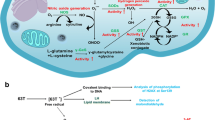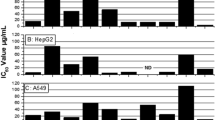Abstract
An attempt to estabilish the relationship between anti-cell adhesive action of phenylacetylshikonin anallogues and their cytotoxicity against A549 cells was done. In the one hour incubation with A549 cells, α-methoxyphenylacetyl-(9), α-acetoxyphenylacetyl-(13), 3,4-methylen-edioxyphenylacetyl-(15) and 4-(N,N-dimethylamino)-phenylacetylshikonin (17) analogues showed a high anti-cell adhesive activity (IC100 value, 4–8 μg/ml), while halophenylacetyl-and dimethoxy-or trimethoxyphenylacetyl analogues expressed no activity at 40 μg/ml, indicating that the presence of a bulky group at C′-α and a polar group at C-4 of phenylacetyl moiety may be important. A similar structure activity relationship exists for the 48 hr cytotoxocity (ED50) of phenylacetylshikonin analogues in A 549 cells, but not in either K562 or L1210 cells. Furthermore, the difference between IC100 values for anti-cell adhesive activity and ED50 values for cytotoxicity of potent compound in A549 cells was not so great (1.5 to 3 times). Based on these observations, it is proposed that the anti-cell adhesive action of phenylacetylshikonins might be responsible for their cytotoxicity in A549 cells.
Similar content being viewed by others
References Cited
Ahn, B. Z., Baik, K. U., Hwang, B. D., Kewon, G. R., and Lim, K., Synthesis and inhibition of DNA Topoisomerase-l.J. Med. Chem., 38, 1044–1047 (1995).
Ahn, B. Z., Song, G. Y., Baik, K. U., and Sok, D. E., Cytotoxicity of acylshikonin analogues against L1210 cells and their antitumor activity against sarcoma tumors.Korean J. of Med. Chem., 6, 98–109 (1996).
Ahn, B. Z., and Sok, D. E., Michael acceptors as a tool for anticancer drug design.Current pharmaceutical design., 2, 247–262 (1996).
Colgateet al., Aust. J. Chem., 32, 2257 (1979).
Demetriou, M., Nabi, I. R., Coppolino, M., Dedhar, S., and Dennis, J. W., Reduced contact inhibition and substratum adhesion in epithelial cells expressing GlcNAc-transferase.J. Cell. Biol., 130, 383–392 (1995).
Irimura, T., Gonzalez, R., and Nicolson, G. L., Effects of tunicamycin on B16 metastatic melanoma cell surface glycoproteins and blood-borne arrest and survival proteins.Cancer Res., 41, 3411–3418 (1981).
Imlay, and Fridovich, I., Exogenous quinones directly ionhibit the respiratory NADH dehydrogenase inEscherichia coli.J. Arch. Biochem. Biophys., 296, 337–346 (1992).
Kanf, M. S., Bernotas, R. C., Harry, B. S., Liu, P. S., and Sunkara, P. S., Castanospermine analogues; their inhibition of glycoprotein processing alphaglucosidases from protein kidney and B16F10 cells.Glycobiology, 5, 47–52 (1995).
Kim, S. H., Song, G. Y., Jin, G. Z., and Ahn, B. Z., Antitumor activity of arylacetylshikonin analogues.,Arch. Pharm. Res., 19, 416–422 (1996).
O'Brien, P. J., Molecular mechanisms of quinone cytotoxicity.Chem. Biol. Interact., 80, 1–41 (1996).
Öllinger,K., and Brunmark, A., Effect of hydroxy substituent position on 1,4-naphtho-quinones toxicity to rat hepacytes.J. Biol. Chem. 266, 21496–21503 (1991).
Pili, R., Chang, J., Partis, R. A., Mueller, R. A., Chrest, F. J., and Passaniti, A., The α-Glucosidase I inhibitior castanospermine alters endothelial cell glycosylation, Prevents angiogenesis, and inhibits tumor growth.Cancer Res., 55, 2920–2926 (1995).
Skehan, P., Streng, R., Vistica, D., and Warren, J. T. New colorimetric cytotoxicity assay for anticancer drug screening.J. Nat. Cancer Inst., 82, 1107–1112 (1990).
Vos, R. M., De Goede, J. H., Hoekstein, M. S., Van Bladeren, P. J., and Van Ommen, B., Irreversible inhibition of rat hepatic glutathione s-transferase isoenzymes by a series of structurally related quinones.Chem. Biol. Interact., 71, 381–392 (1989).
Yamashita, A., Schaub, R. G., Bach, M. K., White, G. J., Toy, A., Ghazal, N. B., Burdick, M. D., Brashler, J. R., and Holm, J. S., 1,4-Dihydroxynaphthoquinones, hydroindoloquinone, benzofurans, and benzothiophenones as inhibitors of 5-lipoxygenase. Synthesis and structure-activity studies.J. Med. Chem., 33, 775–781 (1990).
Author information
Authors and Affiliations
Rights and permissions
About this article
Cite this article
Kim, SH., Song, GY., Sok, DE. et al. Anti-cell adhesive effect of phenylacetylshikonin analogues related to their cytotoxicity in A549 cells. Arch. Pharm. Res. 20, 155–157 (1997). https://doi.org/10.1007/BF02974003
Received:
Issue Date:
DOI: https://doi.org/10.1007/BF02974003




